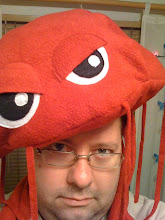
Frankenstein is an iconic word. Thanks to the 1931 movie, and the less-than-stellar sequals, the name conjures a myth very different than what Mary Shelley intended in her book. The name itself is more synonymous with the "monster" than the mad scientist who created life. His first name Victor is meant as an irony. Much like Hammond in Jurassic Park, Victor Frankenstien went too far too fast before a moral compass could be brought to bear. Whereas the movie name became the creature's, the novel's name refers to Victor Frankenstein. After reading half the book this weekend I realize the book is about the downfall of the man and his family, paying a price for Victor's hubris. Surprisingly, the book starts in the arctic as a ship encounters Victor trapped and frozen while hunting his creature. The entire book, save the prologue, is written in first person as Victor tells another person (as if the reader is this other person) the tale of how he arrived in the arctic.
Interestingly enough the actual moment of the creature's birth is handled almost as an off-hand comment in a paragraph, much like he describes an incident with lightning in his youth. There was no drama, just an explanation leading to success. No Igor/Fritz, no assistants, no castles with lightning rods, and he's not even a Doctor. He is so terrified by his success he runs away and goes to bed while the "creature" wanders out of the house and disappears. This event continues to haunt Victor for years as his family is being murdered by something at their peaceful Swiss local. The language of the book is at least English, but somewhat like Jane Austin writing a horror story. The book is 198 pages and about 100 of them are used to describe the history of the Frankenstein family. This does create a fantastic background for the characters so their deaths become more devestating as the book progresses.
At least half the book is a philosophical treaty on human behavior as Mary Shelley is a proponent of nature-over-nurture. She supports the idea that humans are benign and learn to be corrupt and evil as the world, and others, mistreat them. This plays out with the "monster" as it is abused and turns evil, seeking revenge on Victor Frankenstein. This book was published in 1818, almost 200 years ago, and these ideas are still relevant today. Victor Frankenstein's focus of science is to re-animate dead matter and stop death. I recall Anakin wanting the same thing, and he became a "monster" (a bad ass dark Jedi monster). Scientists today are still working on the "fountain of youth." Many of the warnings and ideas are still seen today in sci-fi and pop culture. Trading Places is a comedy of nature-over-nurture. Like the start of the novel, The X Files Season 2 had a two-part mythology episode, "Colony" and "End Game," begining with Mulder in the arctic hunting an alien "bounty hunter" when he is discovered and brought back to health. There is much to the novel and I highly recommend it if you can stomach Victorian verbosity.
The new Battlestar Galactic TV Movie "Razor" aired last night. Having not really followed the series much past Season 1, I was a bit confused by the placement of the episode, as it is considered a "missing episode." It follows the "Pegasus" plot after Lee "Apollo" Adama is given command, but before it is destroyed when it rammed a Cylon BaseStar. There is much given to die-hard fans of the series that went right over my head for a while until things were spelled out. The guest star of the episode is Apollo's new XO, Kendra Shaw, as she helps tell stories in flashback to the events of Pegasus and Admiral Cain, the original CO played by Michelle Forbes (Ensign Ro of Next Generation fame). Once things started moving the story became riviting with Admiral Cain's "Captain Bligh"-inspired brutality to flashbacks of the first Cylon war when Apollo's father was a pilot. He had crashed on a Cylon planet at the end of the war and found a lab being used to make the first Cylon/Human hybrids that pre-date the "Human" Cylons of the present day. Of note is the Pegasus encounter (during the "current" time) with "old" Cylons from the first war that look like the Cylons from the 70s original show, which is just awesome to see, until they move, since the creators decided to make them CG rather than people in shiny chrome suits. WTF? Well, the Cylon Raiders looked awesome and the story ends with a mostly predictable bang, but the journey there is worth it. I've got to spend more time with this franchise. Razor comes out on DVD December 4th, and I'll be there.
The crazy British guy who seems to hate every video game made in his video reviews, except The Orange Box, managed to score a trip to America to visit Half-Life creator Valve. Instead of a scathing game review he posted his travelogue. There are some interesting insights into the gaming companies that others ought to follow before they create a plethora of crap for the new year. Valve is almost like The Borg. See you next broadcast.

No comments:
Post a Comment